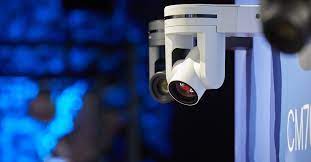High-resolution CCTV cameras are revolutionizing the field of video surveillance with their exceptional clarity and detail capture capabilities. These advanced cameras are equipped with cutting-edge technology that allows for capturing images and videos in stunning high definition, providing unmatched visibility and accuracy in monitoring and recording activities.
One of the key advantages of high-resolution CCTV cameras is their ability to produce sharp and clear images even in challenging lighting conditions. With superior low-light performance and advanced image sensors, these cameras can deliver crisp footage regardless of whether it’s day or night, ensuring round-the-clock surveillance without compromising on quality.
Furthermore, the high resolution of these cameras enables users to zoom in on specific areas of interest without losing clarity or detail. This feature is particularly useful for forensic investigations or identifying individuals or objects in crowded environments where precision is crucial.
In addition to enhancing security measures, high-resolution CCTV cameras also serve as a powerful deterrent against criminal activities. The presence of visible surveillance cameras with exceptional image quality acts as a strong deterrent to potential intruders or wrongdoers, helping prevent incidents before they occur.
With the rapid advancements in technology, high-resolution CCTV cameras continue to evolve, incorporating features such as remote access, motion detection, facial recognition, and integration with smart devices for seamless monitoring and control. These innovations not only improve security measures but also offer convenience and flexibility in managing surveillance systems.
In conclusion, high-resolution CCTV cameras play a vital role in enhancing security protocols across various settings, including homes, businesses, public spaces, and critical infrastructure. Their superior image quality, advanced features, and reliability make them indispensable tools for effective video surveillance solutions that prioritize safety and peace of mind.
Top 5 Benefits of High-Resolution CCTV Cameras: Clarity, Performance, and Advanced Features
- Enhanced image clarity and detail for better identification of individuals and objects.
- Improved low-light performance for clear footage even in dark conditions.
- Ability to zoom in on specific areas without loss of quality for detailed analysis.
- Effective deterrent against criminal activities due to visible surveillance presence.
- Integration with advanced features like remote access and motion detection for enhanced monitoring.
Challenges and Drawbacks of High-Resolution CCTV Cameras
- Higher cost compared to standard resolution cameras
- Require more storage space for high-quality video footage
- Greater bandwidth requirements for transmitting high-resolution video streams
- Increased power consumption due to processing higher resolution images
- May require specialized equipment and infrastructure to fully utilize high-resolution capabilities
- Potential compatibility issues with older surveillance systems or software
Enhanced image clarity and detail for better identification of individuals and objects.
The enhanced image clarity and detail provided by high-resolution CCTV cameras significantly improve the identification of individuals and objects in surveillance footage. With superior image quality, these cameras capture intricate details with precision, making it easier to distinguish faces, clothing, license plates, and other critical features. This capability is invaluable for forensic investigations, security monitoring in crowded areas, and identifying potential threats or suspects with accuracy and confidence. The enhanced clarity offered by high-resolution CCTV cameras plays a crucial role in ensuring effective surveillance and maintaining a safe and secure environment.
Improved low-light performance for clear footage even in dark conditions.
High-resolution CCTV cameras offer a significant advantage with their improved low-light performance, ensuring clear footage even in dark conditions. By utilizing advanced image sensors and technology, these cameras can capture high-quality images and videos with exceptional clarity, detail, and contrast, even when lighting is limited. This capability not only enhances the overall effectiveness of surveillance systems but also provides reliable monitoring and recording capabilities round-the-clock, making high-resolution CCTV cameras a valuable asset for maintaining security and visibility in challenging environments or during nighttime hours.
Ability to zoom in on specific areas without loss of quality for detailed analysis.
The ability of high-resolution CCTV cameras to zoom in on specific areas without any loss of quality is a remarkable advantage that allows for detailed analysis and investigation. This feature enables users to closely examine critical details within the captured footage, such as facial features, license plates, or specific objects, with exceptional clarity and precision. By maintaining high image quality even when zoomed in, these cameras provide valuable information for forensic purposes, identifying individuals or objects, and enhancing overall surveillance effectiveness.
Effective deterrent against criminal activities due to visible surveillance presence.
The prominent advantage of high-resolution CCTV cameras lies in their effectiveness as a deterrent against criminal activities, primarily due to their visible surveillance presence. The mere sight of these advanced cameras with exceptional image clarity acts as a powerful warning to potential wrongdoers, dissuading them from engaging in unlawful behavior. This proactive approach to security not only helps prevent crimes before they happen but also instills a sense of vigilance and accountability among individuals within the monitored area. By leveraging the visibility of high-resolution CCTV cameras as a deterrent tool, businesses, residences, and public spaces can significantly reduce the likelihood of security breaches and unauthorized activities, thereby fostering a safer environment for all stakeholders involved.
Integration with advanced features like remote access and motion detection for enhanced monitoring.
The integration of high-resolution CCTV cameras with advanced features like remote access and motion detection significantly enhances monitoring capabilities. With remote access, users can view live footage and recordings from anywhere at any time, providing real-time surveillance and peace of mind. The inclusion of motion detection technology allows the cameras to detect movement within their field of view, triggering alerts and notifications to alert users of potential threats or suspicious activities. This seamless integration not only improves the efficiency of monitoring but also enables proactive responses to security incidents, making high-resolution CCTV cameras with advanced features a valuable asset for comprehensive surveillance solutions.
Higher cost compared to standard resolution cameras
The primary drawback of high-resolution CCTV cameras is their higher cost compared to standard resolution cameras. The advanced technology and components required to achieve superior image quality and clarity come at a premium price, making high-resolution cameras a more significant investment upfront. This increased cost can be a limiting factor for budget-conscious individuals or organizations looking to implement comprehensive surveillance systems without exceeding their financial constraints. Despite the undeniable benefits of high resolution, the higher initial expenditure may deter some users from opting for these cameras, leading them to consider alternative solutions that offer a balance between cost-effectiveness and performance.
Require more storage space for high-quality video footage
High-resolution CCTV cameras, while offering exceptional image quality and clarity, come with the con of requiring more storage space for high-quality video footage. The increased resolution of these cameras means that the size of each video file is larger compared to standard resolution cameras. As a result, storing and managing the vast amount of high-definition footage can be a challenge, requiring businesses and individuals to invest in larger storage solutions such as hard drives or cloud storage services. This additional storage requirement can lead to higher costs and complexities in maintaining an efficient video surveillance system, especially for long-term retention of footage for security or legal purposes.
Greater bandwidth requirements for transmitting high-resolution video streams
One significant drawback of high-resolution CCTV cameras is the increased bandwidth requirements for transmitting high-definition video streams. The large file sizes generated by high-resolution footage demand more data to be transmitted over networks, resulting in potential strain on existing infrastructure and higher costs associated with data transfer and storage. This can pose challenges for organizations with limited bandwidth capacity or those operating in remote locations where internet connectivity may be limited or unreliable. Additionally, the need for robust network infrastructure to support the transmission of high-resolution video streams can add complexity to system setup and maintenance, requiring careful consideration and investment in network upgrades to ensure smooth and efficient operation of high-resolution CCTV systems.
Increased power consumption due to processing higher resolution images
The con of high-resolution CCTV cameras lies in their increased power consumption attributed to processing higher resolution images. The enhanced clarity and detail captured by these cameras demand more computational power and energy to process and store the larger image files. This heightened power consumption can lead to higher electricity bills and may require additional infrastructure support to ensure continuous operation. As a result, the trade-off between image quality and energy efficiency must be carefully considered when implementing high-resolution CCTV systems to strike a balance between performance and sustainability.
May require specialized equipment and infrastructure to fully utilize high-resolution capabilities
One significant drawback of high-resolution CCTV cameras is that they may necessitate specialized equipment and infrastructure to fully leverage their capabilities. The increased resolution of these cameras means that they generate larger file sizes, requiring more storage space and bandwidth for efficient recording and streaming of high-quality footage. This can lead to additional costs associated with upgrading storage systems, network infrastructure, and monitoring equipment to accommodate the demands of high-resolution video data. Moreover, the installation and maintenance of such specialized equipment may require expertise and technical know-how, posing challenges for users who are not familiar with the complexities involved in optimizing high-resolution CCTV systems.
Potential compatibility issues with older surveillance systems or software
One significant drawback of high-resolution CCTV cameras is the potential compatibility issues that may arise with older surveillance systems or software. Due to the advanced technology and higher image quality of these cameras, older systems may struggle to effectively process and display the high-resolution footage captured by modern cameras. This can lead to challenges in integrating new cameras with existing infrastructure, requiring additional investments in upgrading equipment or software to ensure seamless compatibility. The need for compatibility adjustments can result in increased costs and complexities during the transition to high-resolution CCTV systems, posing a barrier for organizations looking to enhance their surveillance capabilities.




